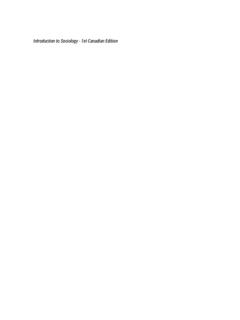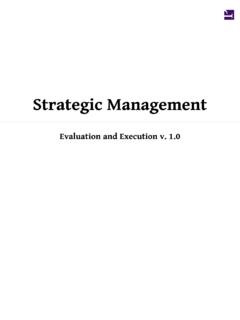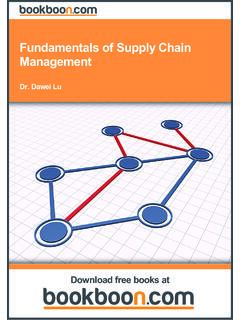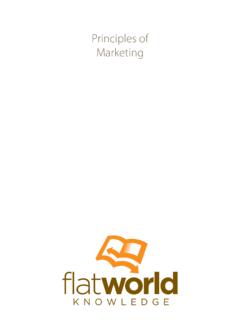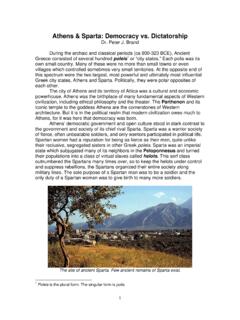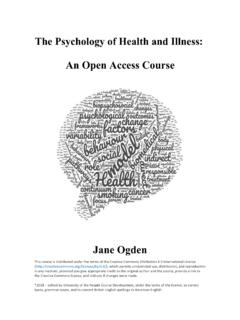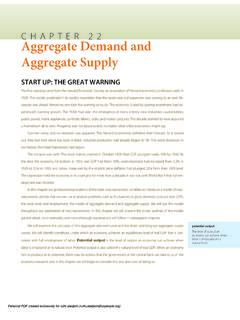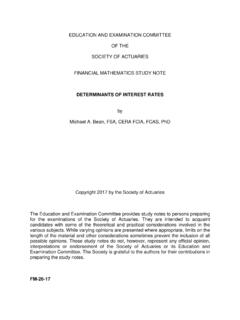Transcription of Money and Banking - University of the People
1 Money and Banking Money and Banking Published by: Flat World Knowledge, Inc. 13 N. Mill Street Nyack, NY 10960. This work is licensed under the Creative Commons Attribution-Noncommercial-Share Alike Unported License. To view a copy of this license, visit send a letter to Creative Commons, 171 Second Street, Suite 300, San Francisco, California, 94105, USA. Printed in the United States of America Brief Contents About the Authors Acknowledgments Preface Chapter 1 Money , Banking , and Your World Chapter 2 The Financial System Chapter 3 Money Chapter 4 interest Rates Chapter 5 The Economics of interest -Rate Fluctuations Chapter 6 The Economics of interest -Rate Spreads and Yield Curves Chapter 7 Rational Expectations, Efficient Markets, and the Valuation of Corporate Equities Chapter 8 Financial Structure, Transaction Costs, and Asymmetric Information Chapter 9 Bank Management Chapter 10 Innovation and Structure in Banking and Finance Chapter 11 The Economics of Financial Regulation Chapter 12 The Financial Crisis of 2007 2008.
2 Chapter 13 Central Bank Form and Function Chapter 14 The Money Supply Process Chapter 15 The Money Supply and the Money Multiplier Chapter 16 Monetary Policy Tools Chapter 17 Monetary Policy Targets and Goals Chapter 18 Foreign Exchange Chapter 19 International Monetary Regimes Chapter 20 Money Demand Chapter 21 IS-LM. Chapter 22 IS-LM in Action Chapter 23 Aggregate Supply and Demand, the Growth Diamond, and Financial Shocks Chapter 24 Monetary Policy Transmission Mechanisms Chapter 25 Inflation and Money Chapter 26 Rational Expectations Redux: Monetary Policy Implications Index Contents About the Authors 1. Acknowledgments 2. Preface 3. Chapter 1 Money , Banking , and Your World 5. Dreams Dashed 5. Hope Springs 7. Suggested Browsing 8. Suggested Reading 8. Endnotes 9. Chapter 2 The Financial System 11. Evil and Brilliant Financiers? 11. Financial Systems 12. Asymmetric Information: The Real Evil 13. Financial Markets 15. Financial Intermediaries 17. Competition Between Markets and Intermediaries 20.
3 Regulation 21. Suggested Reading 23. Endnotes 24. Chapter 3 Money 25. Of Love, Money , and Transactional Efficiency 25. Better to Have Had Money and Lost It Than to Have Never Had Money at 27. All A short History of Moolah 29. Commodity and Credit Monies 30. Measuring Money 33. Suggested Reading 33. Endnotes 34. Chapter 4 interest Rates 35. The interest of interest 35. Present and Future Value 36. Compounding Periods 38. Pricing Debt Instruments 40. What's the Yield on That? 43. Calculating Returns 45. Inflation and interest Rates 46. Suggested Reading 48. Endnotes 49. Chapter 5 The Economics of interest -Rate Fluctuations 51. interest Rate Fluctuations 51. Shifts in Supply and Demand for Bonds 54. Liquidity Preference 58. Predictions and Effects 61. Suggested Reading 63. Endnotes 64. Chapter 6 The Economics of interest -Rate Spreads and Yield Curves 65. A short History of interest Rates 65. interest -Rate determinants I: The Risk Structure 67. The determinants of interest Rates II: The Term Structure 70.
4 Suggested Reading 73. Endnotes 74. Chapter 7 Rational Expectations, Efficient Markets, and the Valuation of Corporate 75. Equities The Theory of Rational Expectations 75. Valuing Corporate Equities 77. Financial Market Efficiency 80. Evidence of Market Efficiency 83. Suggested Reading 86. Endnotes 87. Chapter 8 Financial Structure, Transaction Costs, and Asymmetric Information 89. The Sources of External Finance 89. Transaction Costs, Asymmetric Information, and the Free-Rider Problem 90. Adverse Selection 93. Moral Hazard 95. Agency Problems 97. Suggested Reading 99. Endnotes 100. Chapter 9 Bank Management 101. The Balance Sheet 101. Assets, Liabilities, and T-Accounts 104. Bank Management Principles 106. Credit Risk 111. interest -Rate Risk 113. Off the Balance Sheet 115. Suggested Reading 116. Endnotes 117. Chapter 10 Innovation and Structure in Banking and Finance 119. Early Financial Innovations 119. Innovations Galore 120. Loophole Mining and Lobbying 122.
5 Banking on Technology 123. Banking Industry Profitability and Structure 125. Suggested Reading 129. Endnotes 130. Chapter 11 The Economics of Financial Regulation 131. Public interest versus Private interest 131. The Great Depression as Regulatory Failure 133. The Savings and Loan Regulatory Debacle 136. Better but Still Not Good: Regulatory Reforms 139. Basel II's Third Pillar 140. Suggested Reading 142. Endnotes 143. Chapter 12 The Financial Crisis of 2007 2008 145. Financial Crises 145. Asset Bubbles 146. Financial Panics 148. Lender of Last Resort 150. Bailouts 151. The Crisis of 2007 2008 152. Suggested Reading 154. Endnotes 156. Chapter 13 Central Bank Form and Function 157. America's Central Banks 157. The Federal Reserve System's Structure 159. Other Important Central Banks 161. Central Bank Independence 162. Suggested Reading 165. Endnotes 166. Chapter 14 The Money Supply Process 167. The Central Bank's Balance Sheet 167. Open Market Operations 168.
6 A Simple Model of Multiple Deposit Creation 171. Suggested Reading 173. Endnotes 174. Chapter 15 The Money Supply and the Money Multiplier 175. A More Sophisticated Money Multiplier for M1 175. The M2 Money Multiplier 180. Summary and Explanation 181. Suggested Reading 183. Endnotes 184. Chapter 16 Monetary Policy Tools 185. The Federal Funds Market and Reserves 185. Open Market Operations and the Discount Window 187. The Monetary Policy Tools of Other Central Banks 190. Suggested Reading 191. Endnotes 192. Chapter 17 Monetary Policy Targets and Goals 193. A short History of Fed Blunders 193. Central Bank Goal Trade-offs 195. Central Bank Targets 196. The Taylor Rule 198. Suggested Reading 200. Endnotes 201. Chapter 18 Foreign Exchange 203. The Economic Importance of Currency Markets 203. Determining the Exchange Rate 205. Long-Run determinants of Exchange Rates 207. short -Run determinants of Exchange Rates 209. Modeling the Market for Foreign Exchange 213.
7 Suggested Reading 215. Endnotes 216. Chapter 19 International Monetary Regimes 217. The Trilemma, or Impossible Trinity 217. Two Systems of Fixed Exchange Rates 219. The Managed or Dirty Float 221. The Choice of International Policy Regime 224. Suggested Reading 226. Endnotes 227. Chapter 20 Money Demand 229. The Quantity Theory 229. Liquidity Preference Theory 230. Head to Head: Friedman versus Keynes 232. Suggested Reading 235. Endnotes 236. Chapter 21 IS-LM 237. Aggregate Output and Keynesian Cross Diagrams 237. The IS-LM Model 241. Suggested Reading 244. Endnotes 245. Chapter 22 IS-LM in Action 247. Shifting Curves: Causes and Effects 247. Implications for Monetary Policy 249. Aggregate Demand Curve 251. Suggested Reading 251. Chapter 23 Aggregate Supply and Demand, the Growth Diamond, and Financial Shocks 253. Aggregate Demand 253. Aggregate Supply 255. Equilibrium Analysis 256. The Growth Diamond 259. Financial Shocks 261. Suggested Reading 264. Endnotes 265.
8 Chapter 24 Monetary Policy Transmission Mechanisms 267. Modeling Reality 267. How Important Is Monetary Policy? 268. Transmission Mechanisms 270. Suggested Reading 271. Endnotes 272. Chapter 25 Inflation and Money 273. Empirical Evidence of a Money -Inflation Link 273. Why Have Central Bankers So Often Gotten It Wrong? 276. Suggested Reading 278. Endnotes 279. Chapter 26 Rational Expectations Redux: Monetary Policy Implications 281. Rational Expectations 281. New Keynesians 283. Inflation Busting 284. Suggested Reading 285. Endnotes 287. Index 288. About the Authors ABOUT ROBERT E. WRIGHT. I attribute my enduring interest in Money and Banking , political economy, and economic history to the troubled economic condi- tions of my youth. Born in 1969 in Rochester, New York, to two self-proclaimed factory rats, I recall little of my earliest days except the Great In ation and oil embargo, which stretched the family budget past the breaking point. My only other noneconomic memories are of the Planet of the Apes lms (all ve of them!)
9 And the 1972 Olympics massacre in Munich; my very young mind con ated the two because of the aural similarity of the words gorilla and guerilla. The recession in the early 1980s also injured my family's material welfare and was seared into my brain. After taking degrees in history from Bu alo State College ( , 1990) and the University of Bu alo ( , 1994; , 1997), I. began teaching a variety of courses in business, economics, evolutionary psychology, nance, history, and sociology at Temple University , the University of Virginia, sundry liberal arts colleges, and, since 2003, New York University 's Stern School of Business. I've also been an active researcher, editing, authoring, and co-authoring books about the development of the nancial system (Origins of Commercial Banking , Hamilton Unbound, Wealth of Nations Rediscovered, The First Wall Street, Financial Founding Fathers, One Nation Under Debt), construction economics (Broken Buildings, Busted Budgets), life insurance (Mutually Bene cial), and publishing (Knowledge for Generations).
10 Due to my unique historical perspective on public policies and the nancial system, I've also become something of a media maven, showing up on NPR and other radio shows, as well as various television programs, and getting quoted in major newspapers like the Wall Street Journal, New York Times, Chicago Tribune, and the Los Angeles Times. I. publish op-eds and make regular public speaking appearances nationally and, increasingly, internationally, and I curate for the Mu- seum of American Finance. I wrote this textbook because I strongly believe in the merits of nancial literacy for all. Our nancial system is struggling in part because so many People remain feckless nancially. My hope is that People who read this book carefully, dutifully complete the exercises, and attend class regularly will be able to follow the nancial news and even critique it when necessary. I also hope they will make informed choices in their own nancial lives. ABOUT DR. VINCENZO QUADRINI.
